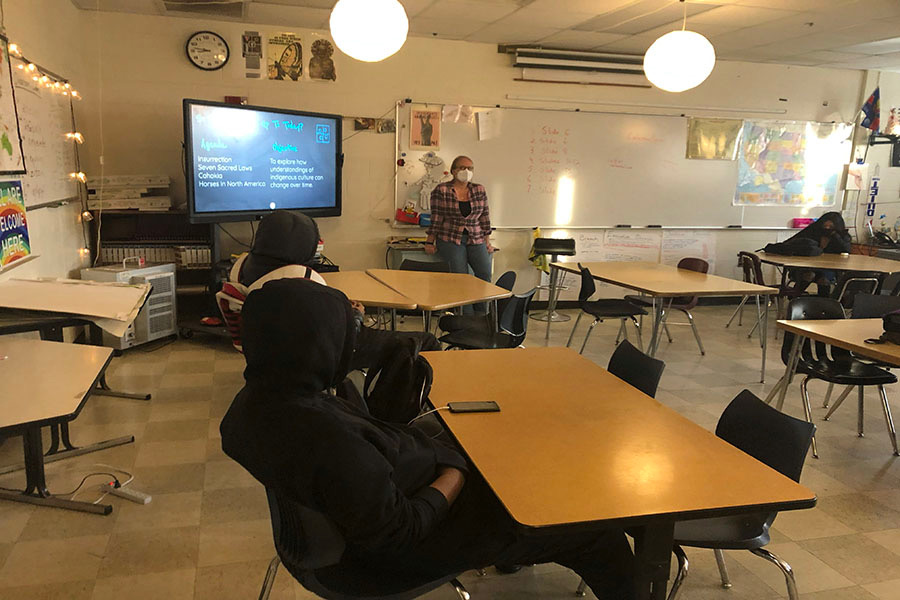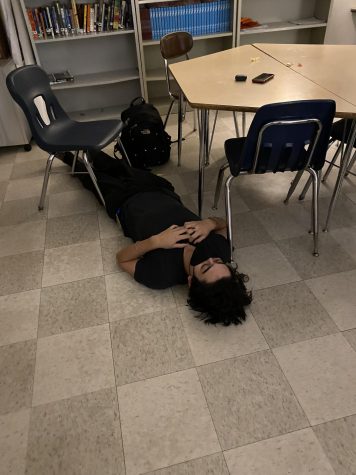How teachers are responding to the effects of distance learning
Going back to in-person school has been challenging for students and teachers alike. As a result, teachers have to get creative to get students back on track socially and emotionally.
January 7, 2022
The end of January marks the end of the first semester of fully in-person learning at South. With students coming back to a harsh transition after a year of slower-paced virtual classrooms, many teachers have felt that their classes are academically behind and their students are less developed socially and emotionally relative to pre-Covid years. And while a host of teachers are implementing their own strategies to try to fix the issues at hand, they are also looking to the now silent administration for guidance.
When asked about the social and emotional challenges of coming back to school for 9th graders math teacher Stephanie Woldum said, “Having a transition in your life as big as that middle school to high school jump and not really having that consistency of being in a building…and getting to have those more formalized connections I think has made this year feel more emotionally and socially disconnected than it would have been otherwise.”
However, Woldum also pointed out that these students are resilient, and while they might lack some academic skills they still possess a lot of ability to learn and to adapt. These students have strengths- she says, “[They] do a pretty good job with noticing [mathematical] patterns and describing them.” Woldum also said that because her class is made up of new 9th graders, she already has strategies she implements in her class that adapt to wherever students come from in terms of math. She calls this idea “Low floor, high ceiling.” This approach could also be used in other classrooms and other grade levels, because now students are coming from a variety of different experiences with distance learning rather than the usual standardized curriculum that preempts the next level class.
While the academic side of things is important, so is the social and emotional development of students. English and Social Studies teacher Delania Haug has noticed differences in that type of development. “I say good morning and have a nice day to every single student at the door as they leave and not one student spoke back to me or even acknowledged my humanity for weeks… They all just walked past me like zombies. I had to say to them… If I directly speak to you, you need to speak back to me; that seems like a really basic thing to teach a high school student.” Haug’s example shows the deeper side of the effects of the pandemic, a side that can’t be cured by a little extra help in class. And we are not fully back either, as Haug points out, “We’re still wearing masks so half of our faces are covered up. Half of our emotion, half of our body language that we express, half of our personality is hidden. And we are trying to get to know each other behind a weird barrier so I think [returning back to normal] is taking longer because of that.”
When asked about how she was trying to resolve some of the issues at hand, Haug said, “We played a lot of games, we did a lot of just getting to know you kind of activities and… they were really happy to be back in school because they wanted to see people again.” And while teachers like Haug can make helpful changes in the classrooms for their students, the administration also has a role to play. She says, “Staff have been pushing for some sort of way to have every student … [have] advisory time and then some downtime. We’ve been trying really hard to push for… some version of student downtime worked into the week or worked into every other week- where every student gets the opportunity to be a part of a group.” Haug says that it’s especially important because, “Some kids work after school and can’t join the Muslim Student Association or the Fashion Club… but that’s where you make your friends, that’s where you bond.”
Creating mandatory downtime in some way, schoolwide, is a simple step the administration can take. In addition, it’s a recommendation by the majority of the staff and student body that has been echoed across the country. But while the administration does have a role to play, they too have been hit hard by the pandemic and its effects. Teacher Joe Hyser said, “There’s really a shortage of staff and they are trying to do everything they can and we had a lot of staff development at the beginning of the year and that was fantastic, but they are really short-handed. Once school gets rolling we’re more reactionary as opposed to the beginning where we are trying to be more proactive so I think a lot of the problems we are experiencing now we could handle them better if we just had more staff.” Recent changes in the administration point to progress, namely the influx of new administrators in the student engagement team. Part of the role of this group is to have a place teachers can bring their concerns about students to. This could play a crucial role in solving issues that arise both in and outside the classrooms.
However, even with these new tools, teachers need overarching support from the administration that is just not there. We need to get students back on track socially and emotionally. As Haug put it, “That stuff is at the top of the list, how to make sure kids’ needs are being met. Every kid.”






